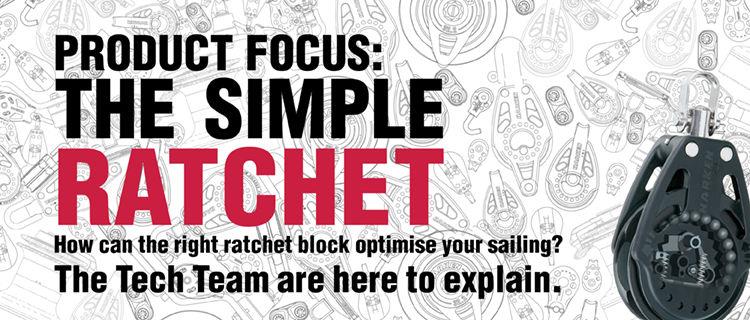
Harken Product Focus: Ratchet Blocks
by Alice Markham 29 Apr 2019 08:45 BST

Harken Product Focus: Ratchet Blocks © Harken UK
With such a huge range of hardware out there, the Harken Tech Team would like to help untangle the different options available. Every month we will be producing a product focus article, giving advice on how to pick the right hardware for the job. This month, we look at the ratchet block: providing vital holding power in breezy or gusty conditions and allowing control and precision when trimming, a ratchet block can be an essential piece of kit for cruising and racing.
 Why use a ratchet block?
Why use a ratchet block?
Contrary to what some might think, a ratchet block does not actually provide any mechanical advantage when pulling a line in. When you pull the line in the sheave turns freely like a normal block, and the clicking you hear is the ratchet pawl dropping into the teeth on the sheave as it rotates. Instead, it provides resistance in the direction of the load with two essential elements: the grip of the sheave on the line and the pawl that prevents the sheave from turning. This means a sailor can hold the load on a line for much longer, which reduces fatigue and makes constant trimming easier, and can ease a loaded line with more precision and control.
Key Features
Ratchet Pawl: A ratchet works when you stop trimming: when the sheave stops rotating, the pawl settles against one of the teeth and, along with the friction of the line in the sheave, holds a portion of the load.
Sheave Grip: When you ease the line, the grip pattern on the sheave causes friction which reduces the load on your hands. There is a balance to be achieved between holding power and line chafe sheaves with too much grip will destroy lines more quickly and may cause lines to stick in lighter conditions, but can provide much more holding power.
At Harken, our standard ratchet block sheaves feature eight facets and are made from hard lube-anodised machined aluminium for strength and corrosion resistance. This design allows maximum holding power whilst still being very kind to rope. We have also just released a 1.5x and 2x grip sheave option for our 57mm and 75mm ratchets, which allows a sailor to tailor their holding power to their preferences and the conditions each day.
The efficacy of the grip will also depend on the type and diameter of lines you are using; if the line is too large or too small it will not make enough contact with the grip pattern to increase holding power. Similarly, if the line is hard or smooth it will not grip in the sheave as well as a softer line will.
Carbo Material: The full range of ratchet blocks is made from the same fibre-reinforced Nylon resin and use the same ball-bearing system as the Carbo range of blocks. This means our ratchet blocks are extremely lightweight, durable, free-running and strong.
Options: Whilst the number of variations of Harken ratchets may seem daunting at first, this actually allows you to tailor the systems on your boat to your exact requirements and preferences for any given conditions; for help on which ratchet will work best for you, read on.
How to pick your ratchet
Size: As with any block, it is important to select the correct size ratchet block for the loads it will be subjected to. Remember that a 180 degrees turn on a block doubles the loading. It is also worth noting that a larger diameter sheave provides more contact area with the line, which in turn provides more holding power. For the same reason, a ratchet block is more effective with a 180 degrees turn as the line is then in contact with as much of the sheave as possible. This is worth thinking about when deciding where in your systems and boats to place your ratchet block.
Switchable or automatic: Some sailors like the option to turn their ratchet function on and off; a switchable ratchet allows you to choose between having a free-running block in lighter airs when there is not enough pressure to pull the rope through the block, or having the ratchet permanently engaged when the wind gets up. The switch is easy to use and is located in the centre of the block so that it cannot be switched accidentally.
The other option is a Ratchamatic® block: the ratchet mechanism in these blocks is only engaged when the block is loaded. This means that when the line is loaded the block helps you hold the load, but when the load is removed the ratchet mechanism disengages and the block becomes free-running. It is possible to change the tension at which the spring engages using the hex-key included with your Ratchamatic® block to suit your own strength and style and the system in which the block is used. Simply turn the hex-key anti-clockwise for heavier loads and clockwise for lighter loads. Harken has also recently released an HTE (high-threshold engagement) option which uses a spring which is 20% stiffer than in our standard blocks. This delays the point at which the ratchet engages, allowing the block to remain free-running for longer.
Shackle or soft-attach: For an even more lightweight ratchet block, our T2 Ratchamatic blocks come in 40mm and 57mm size. The 57mm also comes in the 1.5x and 2x grip options too. A soft-attach blocks accommodates the option to lash the block at varying heights to maintain a perfect lead into the block. The T2 Ratchamatics also feature 50% fewer components which ensures it remains lightweight and reliable.